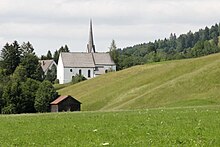Kappelkirche
The pilgrimage church of the Holy Blood in Unterammergau , generally called the Kappelkirche or simply Kappel , is a church building of the Roman Catholic Church . The church is consecrated to the Holy Blood of Christ . Like the sacristan's house next to it, it is registered as a monument in the Bavarian list of monuments.
location
The church is located north of the main town and east of the Ammer in the district of Kappel on a step. The main axis runs roughly in a west-east direction with a deviation of about 20 ° counterclockwise. Together with the neighboring former sacristan's house, the church forms the Kappel district.
history
On the site of today's church, a chapel is first recorded in writing in 1450 . According to oral tradition, however, it is said to be one of the oldest church buildings in the Ammer Valley. The Ammergau Count Eticho is said to have founded a small monastery here as early as 900 . In a visitation report from 1707, the erection of the chapel is described as being caused by a " wonderful event ", without describing the event in more detail. A relic was kept in the chapel . According to tradition, it was part of the Holy Blood relic that Judith, the wife of the Bavarian Duke Welf I , donated to Weingarten Monastery in 1094 . However, this is not documented. Because of the relic, the chapel became a destination for pilgrimages.
In order to offer the pilgrims more space, a new nave was built in 1618 . In 1680 Johann Schmuzer built a new choir with the same height as the nave. Franz Xaver Schmuzer finally gave the interior a uniform appearance in 1750, as it can essentially still be seen today. He pulled in a new vault and stuccoed the church. In 1779, Franz Seraph Zwinck , whose father Johann had been a sacristan at the Kappelkirche, created the ceiling frescoes in the stucco frames already prepared by Schmuzer. Even if the original chapel was replaced by a large church, the church continued to be simply called "Kappel" or "Kappelkirche".
In 1703, during the War of the Spanish Succession, the church was badly damaged and the original relic was stolen. In 1734, today's Holy Blood relic came from Italy to the Kappelkirche. A planned demolition of the church after the secularization was prevented by the population of Unterammergau.
The Kappelkirche has been fundamentally renovated several times, e.g. B. 1892-1896, 1948-1953 and 1961-1966. A complete exterior and interior restoration took place in 2003–2005, in the course of which the chancel and the side altars were redesigned.
Exterior
The building consists of a nave and a choir adjoining it in the east with an apse , which bear a common gable roof . In the corner between the nave and the choir on the northern long side is the square, late Gothic tower with an octagonal pointed helmet . Below the base of the helmet are small, coupled sound openings for the bell chamber . Opposite the tower on the south side of the church is the sacristy.
The nave has two arched windows on both sides , the choir has two crusher windows, which are also arched at the bottom. The entrance to the nave is at the western end of the northern long side.
Interior
After the general restoration at the beginning of the 21st century, the interior of the church essentially has the appearance of the 18th century, as it is characterized by the design by Franz Xaver Schmuzer and the ceiling paintings by Franz Seraph Zwinck. Some furnishings due to liturgical changes in the modern style, such as B. People's altar and ambo into the overall picture.
The interior of the church has a total length of 24.40 m. The nave and the adjoining choir are separated from each other by a triumphal arch . The nave is 13.30 m long and 9.5 m wide, the choir is 11.10 m long and 6.20 m wide. The nave has a height of 8.40 m, the choir of 7.40 m. The nave and choir both have a pressed barrel vault with stitch caps facing the windows, the nave with three bays , the choir with two.
There are two galleries on the back wall. On the top is the original organ, which was created in 1777 by the organ builder Anton Fuchs from Innsbruck.
Two bells hang in the bell-room of the tower. Although they had to be handed in during World War II, they returned undamaged after the end of the war.
literature
- Hans Pörnbacher, Erwin Wiegerling: The churches and chapels of the community Unterammergau . 1st edition. Kunstverlag Josef Fink, Lindenberg 2007, ISBN 978-3-89870-394-9 , p. 21–32 (photos: Erwin Reiter).
- Alexander Heisig: Kappel - Unterammergau . Pilgrimage Church of the Holy Blood. Ed .: Archbishop's Office in Munich. 2005 (documentation of the restoration measures).
Web links
- The Kappelkirche on the website of the Oberammergau Parish Association
- Kappelkirche on the Ammergau Alps site
Individual evidence
- ↑ List of monuments for Unterammergau (PDF) at the Bavarian State Office for Monument Preservation, monument number D-1-80-135-29 and -30
Coordinates: 47 ° 37 '34.6 " N , 11 ° 2' 4.2" E




